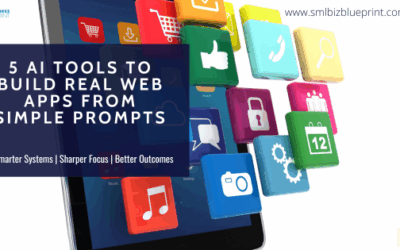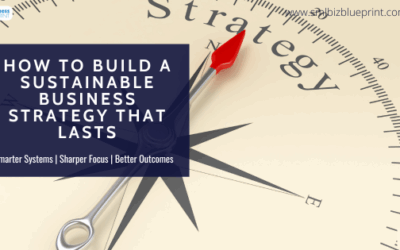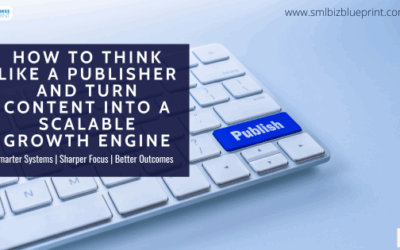Environmental sustainability for small businesses means reducing your environmental impact while enhancing efficiency, fostering trust, and promoting long-term growth.
This guide outlines seven practical, cost-effective steps—from reducing waste and switching suppliers to training your team and engaging customers.
Learn how to implement sustainable practices that support your bottom line and the planet.
Is it possible to reduce your environmental impact without blowing your budget or slowing your growth?
If you’re a small business owner, you’ve probably felt the pressure. Customers are asking for greener options. Packaging costs are climbing. And everywhere you turn, sustainability seems complicated, expensive, or reserved for big corporations with entire ESG departments.
But here’s the truth: environmental sustainability for small businesses isn’t just possible, it’s profitable.
In this guide, we’ll walk you through 7 practical, cost-effective steps you can take to make your business more eco-friendly without sacrificing efficiency or customer experience.
From simple energy-saving actions to smarter packaging choices and supplier swaps, each move is designed to help you cut waste, build trust, and grow with purpose, without falling into the trap of greenwashing.
Let’s break it down and make sustainability your next competitive advantage.

Start with a Simple Environmental Impact Audit
Understanding your environmental impact is the first step to making meaningful change.
Before making decisions about packaging, suppliers, or marketing claims, you need a clear understanding of your business’s current standing. That’s where a simple environmental impact audit comes in—it helps you assess how your operations consume energy, produce waste, and contribute to carbon emissions.
An audit doesn’t have to be complicated or expensive.
Start with the basics: electricity and water usage, waste generation, packaging materials, transportation, and any supply chain touchpoints. Even tracking how often lights are left on overnight or how many single-use items go out the door daily can reveal patterns and opportunities for quick wins.
Free tools, such as Google’s Environmental Insights Explorer or basic spreadsheets, can be a great starting point.
Small businesses often overlook their footprint, but collectively, they create a significant environmental impact.
According to the OECD, small and medium enterprises account for approximately 70% of industrial pollution worldwide. Most of that impact stems not from malice, but from lack of awareness or resources.
An audit bridges that gap by turning invisible issues into visible action points.
Example:
A local design studio tracked its energy usage and discovered that equipment left running overnight added 18% to its electricity bill. With a simple policy change and the use of smart plugs, they cut their energy use and costs, while sharing the improvement with customers as part of their sustainability pledge.
Pro Tip:
Set aside one afternoon per quarter to review your operations with a checklist and fresh eyes—you’ll always find one area for improvement that you missed the last time.
The operations manager had noticed the electricity bill creeping up but chalked it up to longer hours. What they didn’t see was that lights, printers, and unused workstations were running overnight. Once they walked the floor after hours and tracked usage for a week, it was obvious: their biggest cost wasn’t headcount—it was hidden energy drain.
That insight didn’t require a consultant. Just visibility. And it saved them $900/month in the first quarter.
Ready to level up your business?
Sign up for our newsletter and get expert tips delivered weekly.
Cut Costs by Reducing Energy and Resource Waste
Reducing your environmental footprint can also significantly reduce your operating expenses.
For small businesses, energy use is one of the most overlooked areas of waste. Yet, simple changes such as switching to LED lighting, installing motion sensors, or upgrading to energy-efficient appliances can lead to long-term cost savings.
Environmental sustainability for small businesses isn’t just about being eco-conscious; it’s also about running lean and smart.
Start by identifying high-consumption areas and eliminating unnecessary waste.
Review your utility bills and compare them month by month. Are you paying to heat or cool unused spaces? Are computers, lights, and equipment running after hours?
Consider installing smart plugs, utilising programmable thermostats, and setting auto-off schedules for frequently used devices.
These minor adjustments can create noticeable savings without disrupting your operations.
Water usage is another hidden cost that adds up fast.
Restaurants, salons, and other service-based businesses can often reduce water consumption by installing low-flow faucets or switching to high-efficiency dishwashers and washing machines.
Even in office environments, installing sensor taps or dual-flush toilets can have a measurable impact. These improvements not only reduce utility bills but also demonstrate environmental responsibility to customers and staff.
Pro Tip:
Use a shared “Energy Tracker” sheet with your team and challenge each department to reduce its monthly usage—it creates accountability and company-wide buy-in for sustainability.
Choose Sustainable Suppliers and Materials
Your supply chain is a powerful extension of your environmental impact—choose it wisely.
Even if your operations are efficient, the materials and partners you work with could be undermining your sustainability efforts.
That’s why one of the most strategic moves for small businesses in environmental sustainability is evaluating suppliers through a sustainability lens.
Prioritise local, low-impact, and transparent vendors.
Local suppliers reduce your carbon footprint by minimising transport emissions, and they often offer faster turnaround and stronger relationships. When sourcing products or raw materials, look for options that are certified sustainable, recyclable, biodegradable, or made from renewable resources.
Certifications to look for include FSC (for paper), OEKO-TEX (for textiles), and B Corp (for suppliers who meet high standards of social and environmental performance).
Ask suppliers the right questions to assess their sustainability practices.
What kind of packaging do they use? Do they offer carbon-neutral shipping? Can they provide information on how their materials are sourced or processed?
Businesses that are serious about sustainability will have answers ready, and often, alternative options available if you want to go greener.
Pro Tip:
Create a “Sustainable Vendor Checklist” and review your top 5 suppliers. If they can’t meet at least 3 basic sustainability criteria, it may be time to explore new options.
They’d been using the same packaging supplier since year one. No one questioned it—until a junior team member asked why their eco-conscious brand was still using bubble wrap. That question led to a vendor review, which revealed several affordable, sustainable alternatives that not only reduced plastic use but also cut delivery lead times by 20%.
What started as a small question led to a brand-aligned, customer-friendly upgrade.

Make Eco-Friendly Changes to Packaging and Shipping
Packaging and shipping are often your customers’ first tactile experiences with your brand—make them count and make them sustainable.
For many small businesses, packaging is both a major cost and a major source of waste.
Shifting to eco-friendly materials and smarter shipping practices can significantly reduce environmental impact while also reinforcing your brand’s values in a visible way.
Choose packaging that’s recyclable, compostable, or reusable.
Replace plastic mailers and styrofoam with kraft paper, cardboard, cornstarch-based fillers, or mushroom packaging. Look for materials certified by standards like FSC (for paper) or BPI (for compostability).
Avoid glossy finishes or mixed materials that are hard to recycle. Even small tweaks—like eliminating unnecessary inserts—can reduce your footprint and lower shipping costs.
Optimise packaging size and weight to reduce shipping emissions and costs.
Right-sizing your packaging not only minimises material waste, but it also saves on fuel and storage. Additionally, consider consolidating shipments, batching orders, or offering carbon-neutral shipping through services like Sendle, Shopify Planet, or UPS Carbon Neutral.
Pro Tip:
Add a note on your packaging (e.g., “We ship plastic-free” or “Packaging is 100% compostable”)—this turns sustainability into a marketing asset customers will notice and share.
Stay in the know!
Pulse is your go-to resource for the latest trends and proven tactics to grow your business. Subscribe today!
Engage Your Customers in Your Sustainability Journey
Sustainability becomes more powerful—and more profitable—when your customers feel like they’re part of the mission.
Today’s consumers don’t just want eco-friendly products; they want to support businesses that align with their values. By inviting your customers into your environmental sustainability journey, you turn passive buyers into active brand advocates.
Transparency builds trust and loyalty—so share your wins and your work-in-progress.
Let customers know what changes you’ve made, what goals you’re working toward, and what challenges you’re facing. This could be a dedicated sustainability page on your website, behind-the-scenes Instagram Stories, or updates in your email newsletter.
Avoid perfectionism—progress updates are often more relatable and inspiring than polished end results.
Create interactive sustainability touchpoints in the customer experience.
Offer incentives for customers who return packaging, donate to reforestation, or opt for slower, lower-emission shipping.
Let customers round up their order for an environmental cause, or reward them with loyalty points for sustainable actions.
These small initiatives can deepen emotional connection while reducing your business’s environmental impact.
Pro Tip:
Add a simple question post-checkout, such as: “How should we keep you updated on our sustainability efforts?” This creates permission-based engagement and provides a clear communication channel.
Their team had spent months making sustainable changes—switching packaging, refining shipping routes—but hadn’t shared any of it publicly. Then one customer asked, “Do you guys do anything sustainable?” That moment sparked a shift: they created a simple webpage, posted an update on social, and shared a behind-the-scenes story in their newsletter.
The post became their highest-performing content of the quarter, and sparked a 14% increase in repeat purchases.
Train Your Team and Embed Sustainable Habits
A sustainable business isn’t built by leadership alone; team-wide habits and buy-in sustain it.
To make environmental sustainability part of your small business culture, every employee needs to understand their role in reducing impact. When sustainability becomes a shared responsibility, it becomes easier to maintain progress and identify new opportunities for improvement.
Start by creating awareness and practical education.
Hold a short team meeting, a “Green Week,” or even a monthly challenge to highlight sustainable practices. Show your team where energy is being wasted, how to minimise material use, and why it matters to your customers and bottom line.
Maintain a positive and practical tone—celebrate small wins and reward team members for their creative, eco-friendly solutions.
Make sustainability part of your everyday operations—not an afterthought.
Set clear expectations around activities such as turning off unused equipment, reducing paper usage, and consolidating orders to minimise shipping frequency. Add sustainability checkpoints into onboarding, performance reviews, and internal workflows.
By embedding these habits, you create a culture that reinforces your environmental goals without needing constant top-down reminders.
Pro Tip:
Nominate a team sustainability champion—someone who can own updates, gather ideas from staff, and keep the momentum going without overwhelming leadership.
Promote Your Sustainability Practices Without Greenwashing
Sharing your sustainability efforts builds trust, but only if it’s done with transparency and credibility.
Customers want to support environmentally responsible businesses, but they’re also savvy.
Overstated or vague eco-claims can backfire, damaging your reputation and raising red flags. To avoid greenwashing, focus on clarity, accuracy, and proof.
Be specific about what you’re doing—and what you’re still working on.
Instead of saying “we’re eco-friendly,” share real data: “We’ve reduced packaging waste by 40% in the past year,” or “Our shipping materials are now 100% compostable.” Concrete examples show authenticity and make your sustainability efforts relatable and measurable.
Highlight progress over perfection.
You don’t need to be carbon-neutral or plastic-free overnight. Sharing your roadmap, including the challenges and trade-offs, can humanise your brand. Customers appreciate honest efforts more than exaggerated claims.
Consider publishing a short annual sustainability summary, even if it’s just a blog post or infographic.
Utilise trusted certifications and third-party validation to enhance your credibility and strengthen your message.
If your packaging is FSC-certified, your coffee beans are Fair Trade certified, or you offset carbon through a verified platform, please specify. These labels carry weight and give your claims external credibility.
Ensure that the certifications are legitimate and relevant to your business model.
Pro Tip:
Avoid buzzwords like “eco,” “green,” or “earth-friendly” without backup—always pair your claims with data, action, or recognised standards to build trust, not scepticism.
Conclusion
Environmental sustainability for small businesses isn’t just a trend, it’s a strategic decision that can reduce costs, strengthen customer loyalty, and set your brand apart in a competitive market.
From auditing your impact and reducing energy waste, to selecting better suppliers, streamlining packaging, and training your team, every step you take compounds into a smarter, leaner, and more trusted business.
Even better?
You don’t have to be perfect to get started. Small changes, made consistently, lead to big results over time.
Whether you’re motivated by values, profitability, or both, now is the time to align your operations with what customers expect and what the planet needs.
Action Plan
Audit Your Environmental Impact
Review how your business uses energy, water, packaging, and transport.
Use a simple checklist or free tools, such as Google’s Environmental Insights, to identify areas where waste can be reduced.
Reduce Resource and Energy Waste
Swap in LED lighting, unplug devices overnight, and optimise heating/cooling.
Track monthly usage to spot trends and savings opportunities.
Source from Sustainable Suppliers
Evaluate current vendors on environmental criteria: materials, shipping practices, and certifications.
Prioritise local, low-impact, and transparent suppliers where possible.
Rethink Your Packaging and Shipping
Use recyclable, compostable, or reusable materials.
Right-size packaging to cut shipping emissions and costs.
Engage Customers in Your Eco-Efforts
Share your progress and invite customers to participate through opt-ins, rewards, or returns.
Be transparent—even if you’re still a work in progress.
Train Your Team on Sustainable Practices
Integrate sustainability into your team’s culture through checklists, updates, and friendly competitions.
Encourage small daily actions, such as reducing paper use or consolidating deliveries.
Promote Your Efforts Honestly
Avoid vague “green” claims—be specific and measurable.
Use your website, packaging, and emails to share results and build trust.
FAQs
Q1: What does environmental sustainability mean for small businesses?
A1: Environmental sustainability for small businesses means operating in a way that reduces negative impact on the planet by using fewer resources, generating less waste, and adopting eco-friendly practices that support long-term growth.
Q2: Is sustainability expensive for small businesses to implement?
A2: Not necessarily. Many sustainable changes, such as reducing energy use, switching to eco-friendly packaging, or streamlining delivery, can help lower operating costs. Start with low-cost actions and scale over time.
Q3: How do I know where to start with making my business more eco-friendly?
A3: Begin with a simple environmental audit. Review your energy use, packaging, materials, and suppliers. This helps identify easy wins and high-impact areas to focus on.
Q4: What are examples of sustainable practices I can implement today?
A4: You can switch to LED lighting, reduce paper use, consolidate shipping, choose local or certified suppliers, or offer customers minimal or recyclable packaging options.
Q5: How do I promote my sustainability efforts without greenwashing?
A5: Be honest, specific, and transparent. Use data, third-party certifications, and clear examples of what you’re doing. Avoid vague claims like “eco-friendly” unless you can substantiate them.
Q6: How can sustainability improve customer loyalty?
A6: Customers increasingly support brands that align with their values. Sharing your environmental efforts, especially when done authentically, can increase trust, engagement, and repeat business.
Q7: Do I need to be 100% sustainable to talk about it publicly?
A7: No. Sustainability is a journey, not a finish line. You can (and should) share your progress, goals, and ongoing improvements—even if you’re just starting out.
Other Articles
How to Build a Sustainable Business Strategy That Lasts
How to Think Like a Publisher and Turn Content Into a Scalable Growth Engine




